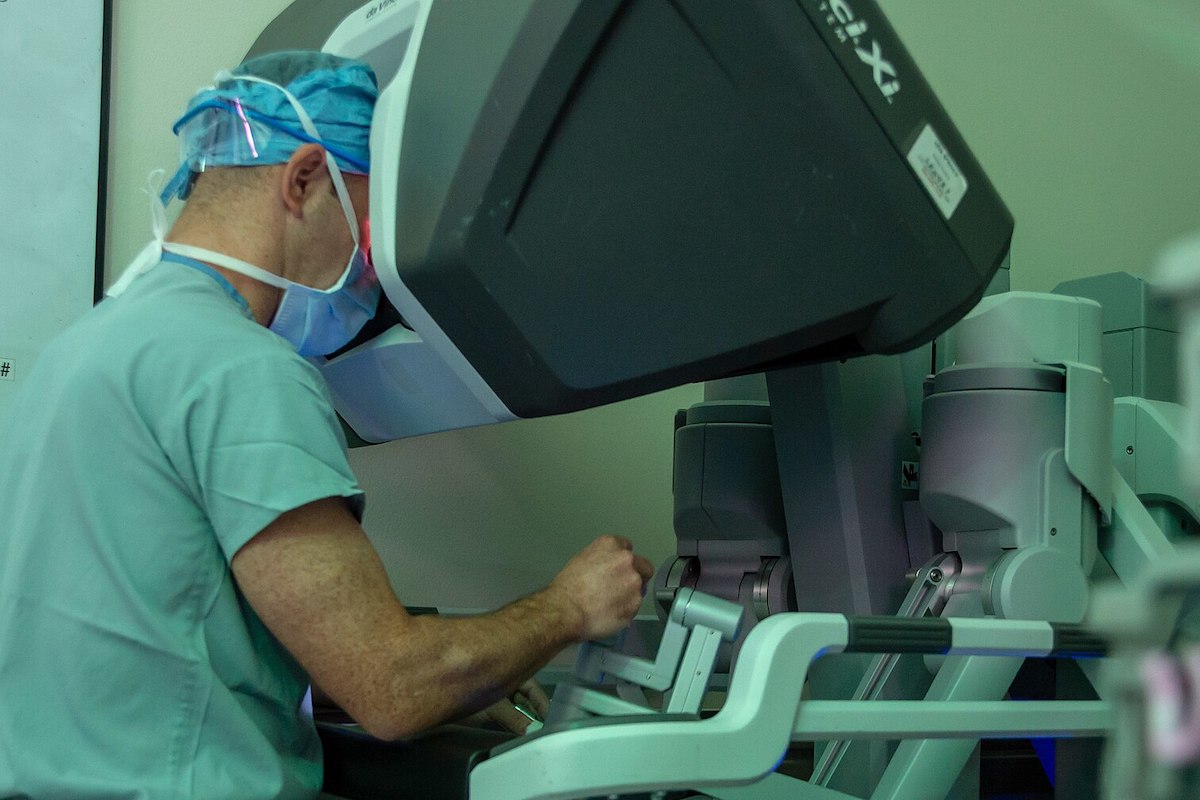Capt. Sean Stroup, a urologist with the U.S. Navy, uses a robotic surgery system to conduct a pyroplasty procedure in August 2020. Similar equipment is used in telesurgery. Public domain image by U.S. Navy Mass Communication Specialist 3rd Class Jake Greenberg
Earlier this year, urologists at the Cleveland Clinic orchestrated a novel procedure in which a doctor delivered high-intensity, focused ultrasound waves to a patient with prostate cancer 7,000 miles away at another Cleveland Clinic hospital in Abu Dhabi. During the intervention, a urologist on site in Abu Dhabi launched a specialized software program and transferred control of a robotic arm used to deliver the therapy to the urologist in Cleveland.
Then, in June, a Florida-based urologist performed a remote prostate removal surgery on a patient with prostate cancer, also 7,000 miles away, in Angola, Africa. In this case, too, local surgeons were available on site as backup.
The Cleveland Clinic case proved that telesurgery could be performed using regular landlines, the urologist told me while reporting on this case recently for Medscape. Meanwhile, the surgeon who performed the case in Africa — Vipul Patel, M.D., medical director of the Global Robotics Institute at AdventHealth in Celebration, Fla. — told ABC News he plans to submit data from the case to the FDA for review in hopes of performing additional procedures.
These are not the first cases of what’s known as telesurgery, but they are part of a trend that’s gaining momentum that could be interesting for journalists to follow, or to pursue stories by interviewing surgeons, patients, and companies that manufacture the surgical software and robots.
How it works
Telesurgery, or remote surgery, uses both robotic surgical systems and wireless networking to connect surgeons to patients who are geographically distant, according to a description from News-Medical.net.
During the intervention, a surgeon sits either at a specialized console or a computer workstation (see da Vinci Robotic Surgery for sample details/pictures) to view a high-definition, 3D view of the surgical site and use controls to direct robotic arms to perform the procedure. Robotic surgeries have been used with the surgeon and patient in the same operating room for 20-plus years in hospitals for heart operations, hysterectomies, gallbladder removals and other types of surgeries.
The first widely known telesurgery occurred in 2001, when surgeons at Mount Sinai Medical Center in New York City performed a gallbladder removal operation on a patient in Strasbourg, France. While the surgery was a success, the procedure (supported by French Telecom) used a transatlantic cable and was considered then to be too expensive to be performed regularly.
Advances in wireless networking/telecommunications now allow the procedures to be done remotely, with minimal latency and time delay in transferring information between what the surgeon does and the robot/patient response on the other side. In the case of the Cleveland Clinic procedure, it was less than 120 milliseconds — imperceptible.
Within the past few years, surgeons in bigger cities in China, Japan and India have been performing robotic urological telesurgeries for patients in remote locations, Patel told me for the Medscape story. He and his colleagues traveled to some of these locations. In China, he performed five robotic prostate removal surgeries on patients up to about 3,100 miles away. In each case, a surgeon colleague was available at the patient’s bedside, ready to take over if necessary, but they never had to intervene. Patel also has performed these procedures remotely within Angola, from one city to another.
There is “a huge interest” in the technology, Patel said.
“All the societies, all the countries, all the robotic companies — I think we’re starting to realize that we can truly help health care equity globally with telesurgery, and everyone’s just jumping on board now,” he told Medscape.
Benefits of telesurgery
There are still several hurdles to overcome, including regulations, achieving a low lag time, cybersecurity concerns and more. However, if telesurgery can grow and be adopted successfully, it could have multiple benefits:
Procedures could be performed for patients in medically underserved locations such as rural areas or battlefields, without the patient needing to travel far from home — or for military personnel, be evacuated far — for treatment and recovery.
It brings surgical expertise to geographic locations that might not otherwise have these experts.
It also allows for real-time teaching, permitting experts in one location to coach surgeons in other locations throughout an operation, or potentially take over part of a procedure remotely to demonstrate a technique. Patel’s training facility is connected to systems in Brazil, Kuwait, Angola, China and Morocco to teach surgeons there.
Story ideas
Interview surgeons who perform these surgeries to understand their experiences. How do they prepare? What’s different/similar from traditional surgeries?
Interview a patient who has undergone the procedures — What made them agree to it?
Talk to medical device manufacturers working on new robots — What capabilities will they have?
Look into the cybersecurity angle — How can surgeons prevent someone from hacking into the connection? How is patient information being securely transmitted and stored?
Resources

